

BLOOMSBURY WILDLIFE Bloomsbury Publishing Plc 50 Bedford Square, London, WC1B 3DP, UK 29 Earlsfort Terrace, Dublin 2, Ireland This electronic edition published in 2021 by Bloomsbury Publishing Plc BLOOMSBURY, BLOOMSBURY WILDLIFE and the Diana logo are trademarks of Bloomsbury Publishing Plc First published in the United Kingdom by Bloomsbury Publishing 2021 This edition published by arrangement with Biotope editions, Meze, France First published in France under the title Cahier didentification des Orthoptres de France, Belgique, Luxembourg et Suisse 2me dition by Biotope editions, Meze. Biotope editions, Meze, France 2015 UK data from the Biological Records Centre's Grasshopper and Cricket (Orthoptera) and related species records from Britain and Ireland to 2007 is used under Creative Commons Attribution 4.0 International Public License. The authors have asserted their right under the Copyright, Designs and Patents Act, 1988, to be identified as Authors of this work. All rights reserved
You may not copy, distribute, transmit, reproduce or otherwise make available this publication (or any part of it) in any form, or by any means (including without limitation electronic, digital, optical, mechanical, photocopying, printing, recording or otherwise), without the prior written permission of the publisher. Any person who does any unauthorised act in relation to this publication may be liable to criminal prosecution and civil claims for damages. Bloomsbury Publishing Plc does not have any control over, or responsibility for, any third-party websites referred to in this book.
All internet addresses given in this book were correct at the time of going to press. The authors and publisher regret any inconvenience caused if addresses have changed or sites have ceased to exist, but can accept no responsibility for any such changes. A catalogue record for this book is available from the British Library. Library of Congress Cataloguing-in-Publication data has been applied for. ISBN: 978-1-4729-5486-2 (PB)
ISBN: 978-1-4729-5487-9 (eBook)
ISBN: 978-1-4729-8490-6 (ePDF) Design by Rod Teasdale To find out more about our authors and their books please visit www.bloomsbury.com where you will find extracts, author interviews and details of forthcoming events, and to be the first to hear about latest releases and special offers, sign up for our newsletters. : front (top): Decticus verrucivorus monspelliensis; (bottom, left to right): Leptophyes punctatissima, Saga pedo, Podisma dechambrei dechambrei; spine: Eupholidoptera chabrieri; back (left to right): Antaxius pedestris, Conocephalus dorsalis, Gomphocerippus rufus. : Roesel's Bush-cricket (Metrioptera roeselii) adult female, clambering through grass, West Canvey Marshes RSPB Reserve, Canvey Island, Thames Estuary, Essex, England, September (Dave Pressland/FLPA).
Contents

Common Field Grasshopper (
Chorthippus brunneus) adult, close-up of head, Leicestershire, England, August. Orthoptera are remarkable for the diversity of their shapes, colours, behaviours, habitats and lifestyles. Of the 27,000 species known worldwide, more than 1,000 occur in Europe (261 taxa are present in the area covered in this field guide). Many are familiar sights on country walks during the day as well as after dark. Grasshoppers can be detected by their jumps, while more discrete species may be found by careful listening, or by searching in specific habitats. With relatively low variation within species but high biological diversity and accessibility, the Orthoptera are a fascinating group of insects to study for all nature enthusiasts.
However, their identification requires appropriate tools. Identification is essential to proper observation: in order to describe what we see, and to compare with what has been documented by others, it is necessary to name specimens. Photographs cannot replace direct examination of characters, but building and maintaining a collection of insect specimens is a time consuming activity and, barring large-scale studies, it is often of little scientific interest. This new guide focuses on the grasshoppers and crickets of Britain and Western Europe. It is an excellent tool to discover the diversity of Orthoptera: small, flexible and lightweight, it can easily fit into a pocket. With its many illustrations, it is intended not only for beginners, who will be able to gain fundamental knowledge about the morphology of insects, but also for experienced orthopterists.
The identification keys combine drawings, photographs (with useful guidance on size) and distribution maps, for a quick assessment of possible options. It provides the best tools to make rapid progress in species identification. The book is accompanied by a CD that offers an overview of the acoustic diversity of Orthoptera. Finally, a brief summary of the biology of the Orthoptera is presented, as an introduction to finding and observing insects in situ. In an era of climate change and major threats to biodiversity, improving our knowledge of the natural world can only help protect it. Everyone can contribute, each in their own way, to its conservation.
Laure Desutter-Grandcolas
Professor at the National Natural History Museum, Paris

Water-meadow Grasshopper (
Pseudochorthippus montanus, female). The identification of Orthoptera can sometimes be a complex task. Until now, the resources available for identification were often outdated, incomplete, or insufficiently illustrated for the amateur. We hope that this guide with its accompanying CD of stridulations will fill this gap, and arouse greater interest in this fascinating group of insects. The general section of this guide focuses on the anatomy, biology and ecology of the Orthoptera, as well as on methods used for their observation and study. We felt it to be important, particularly for beginner orthopterists, to include a description of specialised field equipment that can be used to take photographs, listen to or record sounds.
The second part of this guide contains a richly illustrated key, incorporating the latest taxonomic changes. All 261 species in the region are illustrated with photos (of males and females), for the first time. We have also made a particular effort to update distribution maps, by reviewing various publications and by working with colleagues. In the case of French Orthoptera, more than 1,100 new observations were collected, in addition to those used in the atlas published by the UEF (French Entomology Union) in 2009. Similar updates were undertaken for Belgium and Switzerland, in collaboration with national specialists, and for the UK following the Biological Records Centre's Grasshopper and Cricket (Orthoptera) and related species records from Britain and Ireland to 2007. We would like to thank all those who responded to our requests and shared their precious knowledge with us, thereby directly helping in the creation of the present book.
The authors,
Eric Sardet, Christian Roesti and Yoan Braud

Bormans' Alpine Saddle Bush-cricket (

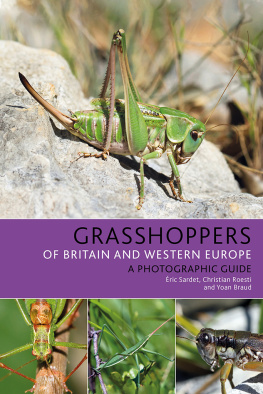


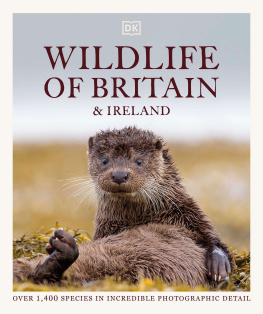
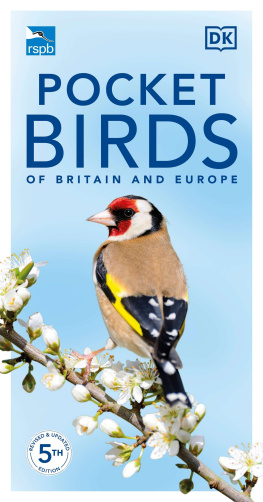
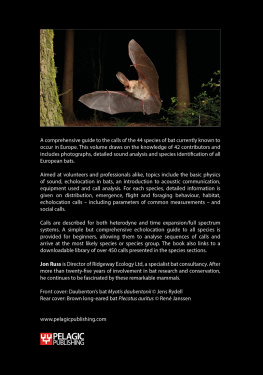
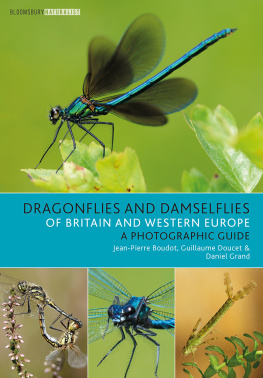
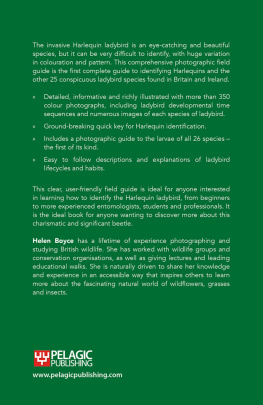

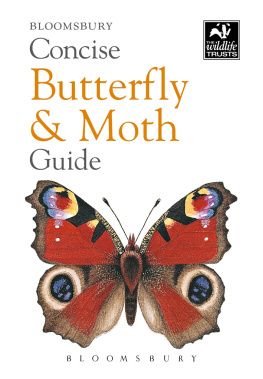
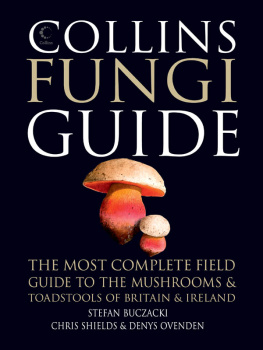

 BLOOMSBURY WILDLIFE Bloomsbury Publishing Plc 50 Bedford Square, London, WC1B 3DP, UK 29 Earlsfort Terrace, Dublin 2, Ireland This electronic edition published in 2021 by Bloomsbury Publishing Plc BLOOMSBURY, BLOOMSBURY WILDLIFE and the Diana logo are trademarks of Bloomsbury Publishing Plc First published in the United Kingdom by Bloomsbury Publishing 2021 This edition published by arrangement with Biotope editions, Meze, France First published in France under the title Cahier didentification des Orthoptres de France, Belgique, Luxembourg et Suisse 2me dition by Biotope editions, Meze. Biotope editions, Meze, France 2015 UK data from the Biological Records Centre's Grasshopper and Cricket (Orthoptera) and related species records from Britain and Ireland to 2007 is used under Creative Commons Attribution 4.0 International Public License. The authors have asserted their right under the Copyright, Designs and Patents Act, 1988, to be identified as Authors of this work. All rights reserved
BLOOMSBURY WILDLIFE Bloomsbury Publishing Plc 50 Bedford Square, London, WC1B 3DP, UK 29 Earlsfort Terrace, Dublin 2, Ireland This electronic edition published in 2021 by Bloomsbury Publishing Plc BLOOMSBURY, BLOOMSBURY WILDLIFE and the Diana logo are trademarks of Bloomsbury Publishing Plc First published in the United Kingdom by Bloomsbury Publishing 2021 This edition published by arrangement with Biotope editions, Meze, France First published in France under the title Cahier didentification des Orthoptres de France, Belgique, Luxembourg et Suisse 2me dition by Biotope editions, Meze. Biotope editions, Meze, France 2015 UK data from the Biological Records Centre's Grasshopper and Cricket (Orthoptera) and related species records from Britain and Ireland to 2007 is used under Creative Commons Attribution 4.0 International Public License. The authors have asserted their right under the Copyright, Designs and Patents Act, 1988, to be identified as Authors of this work. All rights reserved Common Field Grasshopper (Chorthippus brunneus) adult, close-up of head, Leicestershire, England, August. Orthoptera are remarkable for the diversity of their shapes, colours, behaviours, habitats and lifestyles. Of the 27,000 species known worldwide, more than 1,000 occur in Europe (261 taxa are present in the area covered in this field guide). Many are familiar sights on country walks during the day as well as after dark. Grasshoppers can be detected by their jumps, while more discrete species may be found by careful listening, or by searching in specific habitats. With relatively low variation within species but high biological diversity and accessibility, the Orthoptera are a fascinating group of insects to study for all nature enthusiasts.
Common Field Grasshopper (Chorthippus brunneus) adult, close-up of head, Leicestershire, England, August. Orthoptera are remarkable for the diversity of their shapes, colours, behaviours, habitats and lifestyles. Of the 27,000 species known worldwide, more than 1,000 occur in Europe (261 taxa are present in the area covered in this field guide). Many are familiar sights on country walks during the day as well as after dark. Grasshoppers can be detected by their jumps, while more discrete species may be found by careful listening, or by searching in specific habitats. With relatively low variation within species but high biological diversity and accessibility, the Orthoptera are a fascinating group of insects to study for all nature enthusiasts.  Water-meadow Grasshopper (Pseudochorthippus montanus, female). The identification of Orthoptera can sometimes be a complex task. Until now, the resources available for identification were often outdated, incomplete, or insufficiently illustrated for the amateur. We hope that this guide with its accompanying CD of stridulations will fill this gap, and arouse greater interest in this fascinating group of insects. The general section of this guide focuses on the anatomy, biology and ecology of the Orthoptera, as well as on methods used for their observation and study. We felt it to be important, particularly for beginner orthopterists, to include a description of specialised field equipment that can be used to take photographs, listen to or record sounds.
Water-meadow Grasshopper (Pseudochorthippus montanus, female). The identification of Orthoptera can sometimes be a complex task. Until now, the resources available for identification were often outdated, incomplete, or insufficiently illustrated for the amateur. We hope that this guide with its accompanying CD of stridulations will fill this gap, and arouse greater interest in this fascinating group of insects. The general section of this guide focuses on the anatomy, biology and ecology of the Orthoptera, as well as on methods used for their observation and study. We felt it to be important, particularly for beginner orthopterists, to include a description of specialised field equipment that can be used to take photographs, listen to or record sounds.  Bormans' Alpine Saddle Bush-cricket (
Bormans' Alpine Saddle Bush-cricket (